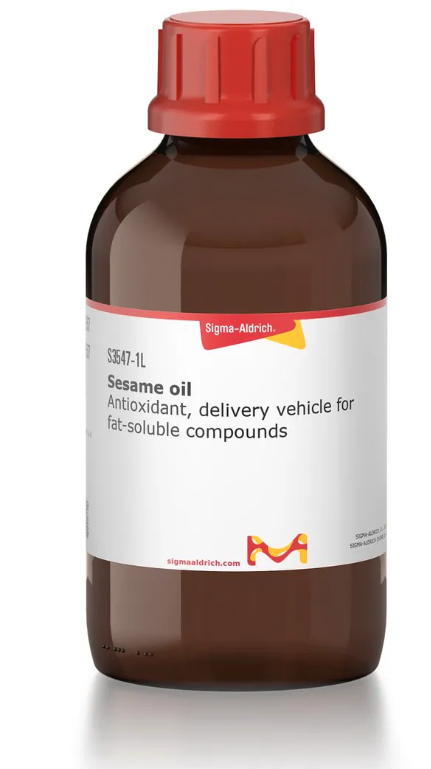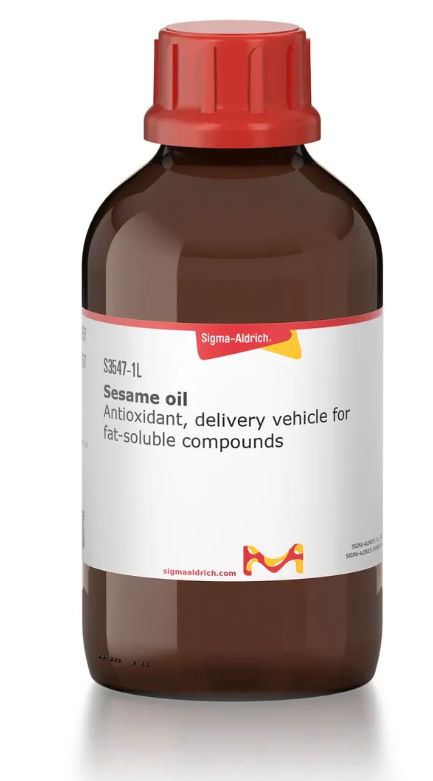芝麻油,Sesame oil,Antioxidant, delivery vehicle for fat-soluble compounds,99%
产品编号:Sigma-S3547 | CAS NO:8008-74-0| MDL NO:MFCD00132243| 分子式:Null| 分子量:Nul
芝麻油可用作赋形剂,如油溶性物质载体、溶剂等。药用赋形剂或药用助剂,是指除药用成分外,在制药过程中使用的其他化学物质。药用辅料一般是指药物制剂中的非活性成分,可以提高药物制剂的稳定性、溶解性和加工性。药用赋形剂还影响共同给药药物的吸收、分布、代谢和消除(ADME)过程。
本网站销售的所有产品仅用于工业应用或者科学研究等非医疗目的,不可用于人类或动物的临床诊断或者治疗,非药用,非食用,
| 产品名称 | 芝麻油 | |||||||||||||||||||||||||||||||||||||||||||||||||||||||
|---|---|---|---|---|---|---|---|---|---|---|---|---|---|---|---|---|---|---|---|---|---|---|---|---|---|---|---|---|---|---|---|---|---|---|---|---|---|---|---|---|---|---|---|---|---|---|---|---|---|---|---|---|---|---|---|---|
| 英文名称 | Sesame oil,Antioxidant, delivery vehicle for fat-soluble compounds | |||||||||||||||||||||||||||||||||||||||||||||||||||||||
| CAS编号 | 8008-74-0 | |||||||||||||||||||||||||||||||||||||||||||||||||||||||
| 产品描述 | 芝麻油可用作赋形剂,如油溶性物质载体、溶剂等。药用赋形剂或药用助剂,是指除药用成分外,在制药过程中使用的其他化学物质。药用辅料一般是指药物制剂中的非活性成分,可以提高药物制剂的稳定性、溶解性和加工性。药用赋形剂还影响共同给药药物的吸收、分布、代谢和消除(ADME)过程。 | |||||||||||||||||||||||||||||||||||||||||||||||||||||||
| 产品密度 | 0.92 g/mL at 25 °C | |||||||||||||||||||||||||||||||||||||||||||||||||||||||
| 溶解性数据 | 应用芝麻油适合: 用于溶解游离睾丸激素 用于制备它莫西芬(腹腔注射) 用于溶解可芳香化的雄激素睾丸激素和不可芳香化的雄激素 5α-二氢睾丸激素 作为雌二醇苯甲酸酯注射的载体 用于溶解孕酮和雌二醇-17β 用于溶解乙酰基十一酮-β-乳香酸的半合成形式 在研究应用中,用作脂溶性化合物(包括甾体激素和毒素)的传递载体。 芝麻油具有抗氧化特性,研究表明在动物模型中可以抵抗脂多糖(LPS)刺激的氧化应激。 | |||||||||||||||||||||||||||||||||||||||||||||||||||||||
| 体内研究 | 芝麻油可用于生产生物柴油,并可作为柴油的可行替代品。当作为膳食补充剂时,它可作为一种抗氧化剂,对局灶性脑缺血的大鼠脑海马具有神经保护活性。食用芝麻油对糖尿病大鼠的血糖、糖基化血红蛋白、脂质过氧化和抗氧化剂水平具有有益的影响。 | |||||||||||||||||||||||||||||||||||||||||||||||||||||||
| 细胞实验 |
| |||||||||||||||||||||||||||||||||||||||||||||||||||||||
| 稳定性 | 生物来源Sesamum indicum (sesame) 质量水平形式liquid 密度0.92 g/mL at 25 °C 官能团oleic acid 运输ambient 储存温度room temp | |||||||||||||||||||||||||||||||||||||||||||||||||||||||
| 储存条件 | 常温避光保存。 |
相关文档
化学品安全说明书(MSDS)
下载MSDS质检证书(COA)
相关产品
| 个人防护装备 | Eyeshields;Gloves |
|---|---|
| 危险品运输编码 | NONH for all modes of transport |
| RTECS号 | VU3940000 |
| 闪点(华氏) | >230 °F |
| 闪点(摄氏) | >110 °C |
Mechanisms underlying the anti-inflammatory actions of boswellic acid derivatives in experimental colitis.
C Anthoni et al.
American journal of physiology. Gastrointestinal and liver physiology, 290(6), G1131-G1137 (2006-01-21)
Recent clinical trials of the gum resin of Boswellia serrata have shown promising results in patients with ulcerative colitis. The objective of this study was to determine whether a semisynthetic form of acetyl-11-keto-beta-boswellic acid (sAKBA), the most potent anti-inflammatory component
Transesterified sesame (Sesamum indicum L.) seed oil as a biodiesel fuel.
Abdurrahman Saydut et al.
Bioresource technology, 99(14), 6656-6660 (2008-01-08)
The sesame (Sesamum indicum L.) oil was extracted from the seeds of the sesame that grows in Diyarbakir, SE Anatolia of Turkey. Sesame seed oil was obtained in 58wt/wt%, by traditional solvent extraction. The methylester of sesame (Sesamum indicum L.)
Effect of dietary sesame oil as antioxidant on brain hippocampus of rat in focal cerebral ischemia.
Saif Ahmad et al.
Life sciences, 79(20), 1921-1928 (2006-07-11)
Oxidative stress may be regarded as an imbalance between free radical production and opposing antioxidant defenses. Free radical oxidative stress is implicated in rat cerebral ischemia and naturaceutical antioxidants are dietary supplements that have been reported to have neuroprotective activity.
Sex-Specific Effects of Progesterone on Early Outcome of Intracerebral Hemorrhage.
Justin T Hsieh et al.
Neuroendocrinology, 103(5), 518-530 (2015-09-12)
Preclinical evidence suggests that progesterone improves recovery after intracerebral hemorrhage (ICH); however, gonadal hormones have sex-specific effects. Therefore, an experimental model of ICH was used to assess recovery after progesterone administration in male and female rats. ICH was induced in
Transient prenatal androgen exposure produces metabolic syndrome in adult female rats.
Marek Demissie et al.
American journal of physiology. Endocrinology and metabolism, 295(2), E262-E268 (2008-06-12)
Androgen exposure during intrauterine life in nonhuman primates and in sheep results in a phenocopy of the reproductive and metabolic features of polycystic ovary syndrome (PCOS). Such exposure also results in reproductive features of PCOS in rodents. We investigated whether








 浙公网安备 33010802013016号
浙公网安备 33010802013016号